The sixth International Symposium on EMC, or
EMC Europe 2004, was held in the Auditorium of the Eindhoven University
of Technology, The Netherlands, from September 6-10. The local
organizing committee consisted of Professors J. Blom, P. Wouters
and S. Kapora of that University, P. Beeckman and M. Coenen from
Philips, Professor F. Leferink from the Twente University of Technology
and Thales Netherlands, Professor J. Catrysse from the KHBO in
Bruges, Belgium and W. John from the Fraunhofer Institute, Germany.
Even on the small scale of the Local Organizing Committee (LOC),
the Symposium was quite international. The staff of the Eindhoven
University Congress Office also took a large part of the organization.
Technical Co-Sponsorship from the IEEE EMC Society and URSI further
emphasized the international character.
The board of reviewers consisted of 70 members, the majority being
from academia. At this Symposium, however, an increased number
of reviewers also came from industry and technological institutes.
The reviewers had to judge 232 extended abstracts on a short term.
The final number of papers that were accepted by the International
Steering Committee, and submitted as a full-length paper by the
authors, was 179. Three parallel oral sessions accommodated about
two thirds of the papers; one third was presented in the poster
sessions. The division of the papers between oral/poster sessions
followed in many cases the author’s preference, but the proceedings
made no distinction between the types of presentation.
The 353 attendees came from all parts of the world; as seen from
Eindhoven, from the North of Sweden to South Africa, from the
US to Japan. It should be noted that the Chinese attendance was
remarkably high.
Sessions with a particularly large number of contributions were
Numerical Modeling, Human Exposure, Measurement and Instrumentation,
Communication and Wireless Systems, Railway, Cables and Coupling,
Anechoic Rooms and Reverberation Chambers, and last and largest:
Printed Circuit Boards and Integrated Circuits.
LOC member Pierre Beeckman arranged an extensive program of eleven
high quality workshops and four excellent tutorials, all with
lectures of 1/2 hour each. Papers were varied and were comprised
of topics such as measuring techniques and statistical aspects
of EMC testing, as well as EMC prediction tools for ICs and PCBs.
Discussions during and after these sessions were as expected;
that is, they were intense!
LOC member Frank Leferink was mainly responsible for the Technical
Exhibition, and he performed this task with great success since
it was fully booked.
The Auditorium is a compact building with 16 spacious rooms perfectly
equipped for lectures. Four of these rooms and the main auditorium
room were reserved for the Symposium. The others were occupied
for normal teaching, since the academic year had started the week
before the Symposium; in fact, the presence of the students added
to a lively atmosphere. The large central hall housed the Technical
Exhibition and the poster session, as well as the afternoon refreshment
distribution. Since there were no oral sessions together with
the posters, all events in that hall were well attended.
In the opening session, Van Deursen as chairman welcomed the audience
and thanked the people who contributed to organizing this Symposium.
Rector Magnificus Professor R. van Santen informed the audience
about facts, position and goals of the Eindhoven University. Professor
M. D’Amore, P. Berkhout from Philips Digital Systems Laboratories,
and IEEE EMCS President K. Williams expressed their views on EMC
Europe Symposia. Professor F. Silva from UPC announced the attractive
venue for the next EMC Europe in 2006: Barcelona, Spain. Keynote
speaker A. van der Poel, Chairman of the EU Eureka Project Medea+,
gave a very impressive presentation on the importance of the semiconductor
industry for the European Union, and the role EMC plays therein.
The social program was varied. It began with a get-together party
at the university after the first day. During the lunch on Tuesday,
the Symposium chairman welcomed his guests by playing the grand
organ of the Auditorium. The cocktail party on that second day
was held in the DAF Museum, which has a perfect acoustic for the
gypsy orchestra ‘Kabani’ from Amsterdam. The congress
dinner was held in the 13th century castle Henkenshage, where
one of the eight still practicing wooden shoe makers of The Netherlands
showed his art, and the ‘Speellieden van Gelre’ sang
and played early medieval music on original instruments.
During the Symposium dinner, Professor M. D’Amore granted
the best paper award to presenting author N. V. Kantartzis from
the University of Thessaloniki, Greece, for his paper titled:
‘Unconditionally stable numerical modeling and broadband
optimization of arbitrarily-shaped anechoic and reverberating
EMC chambers’, which he wrote together with T. D. Tsiboukis.
The Symposium committee provided no parallel guest program since
in The Netherlands many interesting places can be reached within
about an hour of train travel from Eindhoven. The website had
already gave some tour information, and friendly students from
the Breda school for tourism assisted attendees by providing on-the-spot
advice.
Professor D’Amore resigned as chairman of the International
Steering Committee. In its meeting on Monday evening, the ISC
voted for Professor J. Catrysse as his successor. He has the honorable
task to keep one of the largest EMC Symposia in Europe at the
high level of quality and of attendance.
From the many comments received after the Symposium, it can be
concluded that EMC Europe 2004 has been a worthy successor of
the earlier editions. The atmosphere was cordial and relaxed.
The compact architecture of the Auditorium made socializing easy,
since all activities occurred within a short distance of each
other. And finally, the outdoor weather was excellent! At least
for the week of the Symposium, because afterwards it was not quite
as nice. EMC
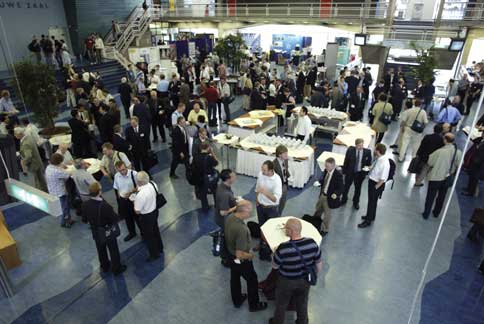 |
| The Technical Exhibition and Poster Sessions were in
the same area, and were well attended. |
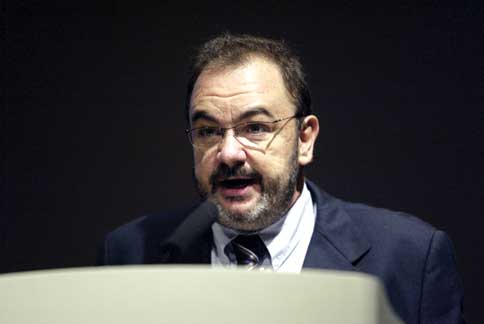 |
| Professor Ferran Silva announces the venue for the next
EMC Europe in 2006: Barcelona, Spain. |
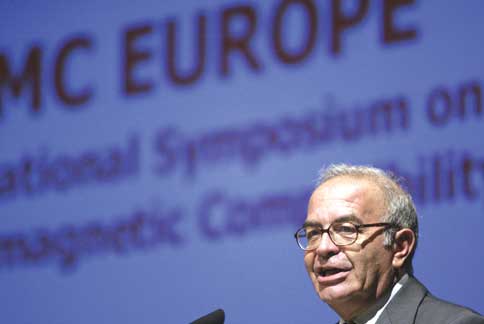 |
| After all, it was Professor Marcello D’Amore who
started this successful series of Symposia! |
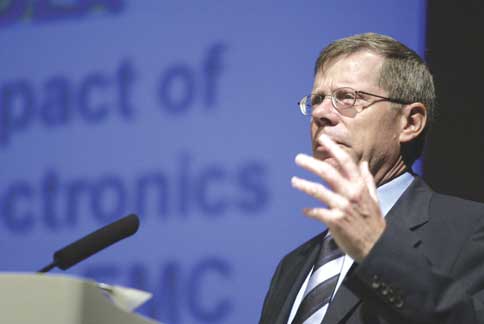 |
| Chairman of the EU Eureka Project
Medea+, Arthur van der Poel, informs the audience of the ambitions
of the European semiconductor industry, and the important
role of EMC. |
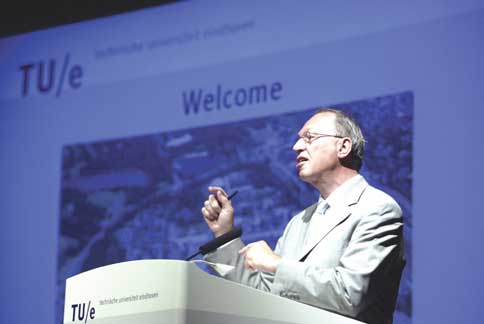 |
| Professor R. van Santen welcomes
the guests to the Eindhoven University of Technology. |
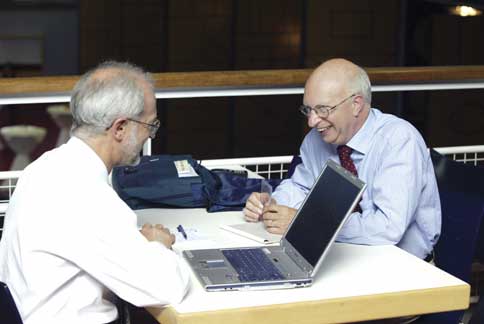 |
| The newly elected chairman of the
ISC, Professor Johan Catrysse (right), had a lively discussion
with R. Marshall after the well-attended workshop on cabling. |
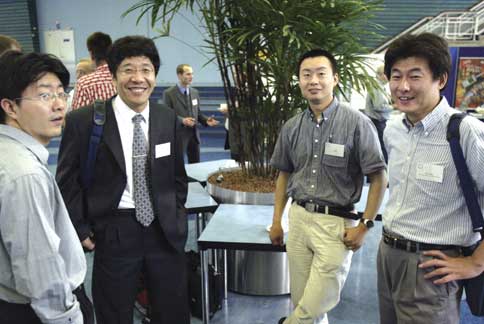 |
| Professor X. Cui (second from
left) and other members of the Chinese delegation at the Symposium. |
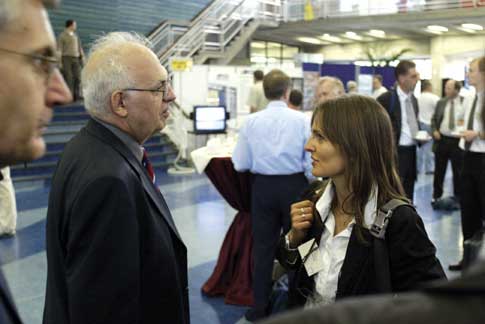 |
| Bruno Audone (left) and Michela Audone
discuss EMC matters during EMC Europe 2004. |
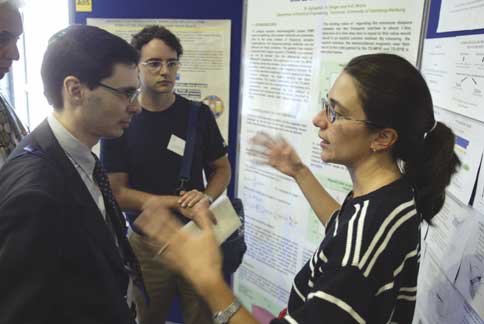 |
| Paola Russo (right) from the “Università
Politecnica delle Marche” visited with Emanuele Piuzzi
from the University of Rome “La Sapienza” during
the poster session. |
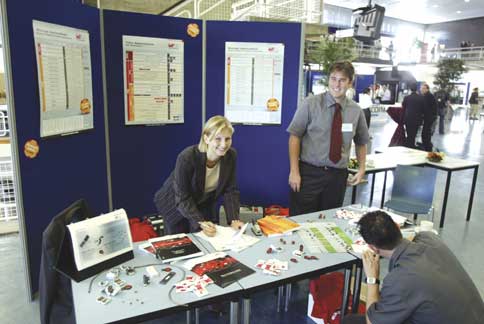 |
| Many well-known equipment manufacturers
displayed their new products at the Technical Exhibition,
including Würth Elektronik GmbH & Co. |
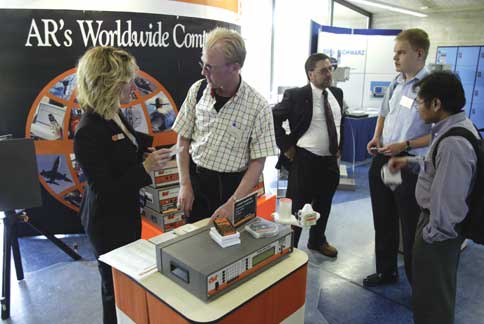 |
| Amplifier Research enjoyed the exhibition
traffic at EMC Europe 2004. |
 |
| It is a great organ, well suited
for the Chairman to welcome the participants with the D-minor
Toccata and Fugue by J.S. Bach. |
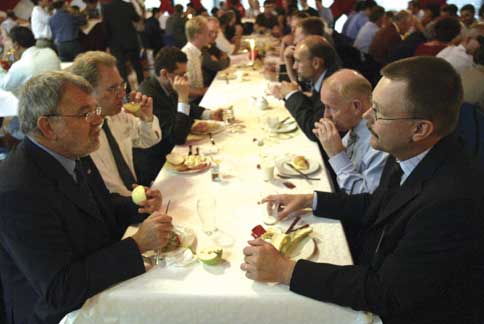 |
| Lunches in the ‘Senaatszaal’
were informal. EMCS President Kimball Williams discusses with
Professor J.Blom (second row left to right), and C. van der
Dries of the Dutch EMC-ESD Society talks to F. Leferink (foreground
left to right). |
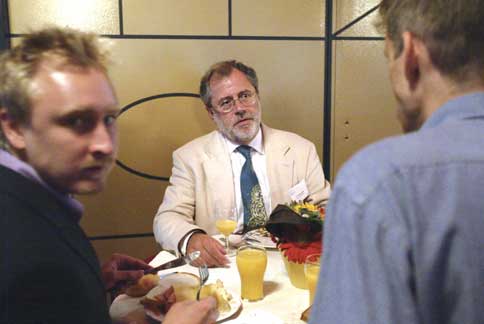 |
| Professor C. Christopoulos lecturing,
also during lunch. |
|
|
|
 EMC
Europe 2004
EMC
Europe 2004












